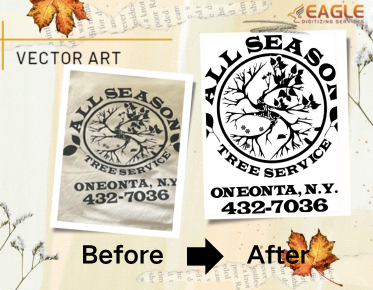From Stitch to Screen: Finding the Best Embroidery Software
Embroidery is a timeless craft that has evolved alongside
technology. Whether you’re stitching designs as a hobby or running a professional
embroidery business, finding the right software is essential for maximizing
your creative potential. But before diving into the vast world of embroidery
software, it’s crucial to understand your specific needs. What’s your skill
level? Are you a casual hobbyist or a seasoned pro? Let’s explore what you need
to consider before investing in the right tools.
Identifying Your Skill Level:
Beginner, Intermediate, or Pro?
The first step in choosing embroidery software is recognizing your
skill level. If you're a beginner, you’ll want software that’s intuitive and
user-friendly. At this stage, simplicity is key—you’ll likely be focusing on
basic designs and fonts rather than complex customizations. Intermediate users
might need more advanced features like design editing or digitizing, while
professionals will require top-tier capabilities such as multi-needle machine
compatibility, automatic stitch optimization, and integration with advanced
commercial equipment. Knowing your skill level will help narrow down your options
and ensure you don’t end up with a tool that's either too basic or overly
complicated for your needs.
Hobbyist vs. Professional
Embroidery: Different Software, Different Goals
There’s a stark contrast between hobbyist and professional embroidery
software. Hobbyists often seek creativity and simplicity, preferring software
that offers pre-built design libraries and easy customization. Professionals,
on the other hand, focus on efficiency, speed, and scalability. Their needs may
include features like bulk processing, multi-needle machine compatibility, and
professional-grade stitch settings. Whether you’re creating a custom shirt for
a friend or running a full-scale embroidery business,
understanding whether you're embroidering for fun or profit will steer you
toward the right software solution.
Common Embroidery Tasks You Want
to Simplify
No matter your skill level or goals, certain tasks remain essential in
embroidery. From creating basic text designs to digitizing intricate artwork,
there are common pain points for all embroiderers. Simplifying tasks like color
management, pattern resizing, and file format conversions can save hours of
trial and error. Look for software that offers automatic stitch count
adjustments, easy-to-navigate design previews, and intuitive file management to
streamline your workflow.
Key
Features to Look For
When selecting embroidery software, it’s crucial to hone in on
specific features that will make your life easier and your designs more
polished. Here’s a breakdown of the must-have elements.
User-Friendly
Interface: Keeping it Simple
A cluttered, complicated interface can stifle your creativity and
waste valuable time. Whether you’re a beginner or an experienced professional,
a simple and intuitive interface is paramount. The best embroidery software
minimizes the learning curve with easy drag-and-drop tools, clear navigation,
and organized menus. Look for software that allows you to jump straight into
your projects without getting bogged down by unnecessary settings.
Customization
Capabilities: From Fonts to Stitches
Customization is where embroidery software really shines. At a basic
level, you want a variety of fonts and stitch types to choose from. But as you
progress, you may want to dive deeper into modifying the very structure of your
designs. Can you adjust stitch density, angles, and lengths? Does the software
allow you to create custom designs from scratch or manipulate existing
patterns? These are essential factors that can elevate your embroidery work
from good to great.
File
Compatibility and Supported Formats
Embroidery software must work seamlessly with the machines and systems
you’re using. Whether you’re working with a commercial multi-needle machine or
a personal home embroidery machine, the software
needs to be compatible with various file formats. Formats like PES, DST, and
EXP are commonly used, but different machines require different types of files.
Ensure the software supports a broad range of file types to prevent the hassle
of constantly converting files.
Compatibility
Considerations
Your embroidery software should not exist in a vacuum. Consider how
well it integrates with your existing setup—your computer, operating system,
embroidery machine, and even other software you may already be using.
Compatibility issues can be a major headache, so doing some upfront research is
essential.
Operating
System Requirements: Windows, Mac, and Beyond
Not all embroidery software plays nice with every operating system.
Windows is still the dominant platform for embroidery software, but there are
options available for Mac users as well. Some advanced embroideryprograms may also offer web-based platforms or Linux compatibility.
Before purchasing, check the system requirements and ensure that the software
is fully compatible with your operating system to avoid any installation or performance
issues.
Software
Integration with Your Existing Tools
Many embroiderers use additional tools, such as design software (Adobe
Illustrator or CorelDRAW) or pattern-making programs. Check if the embroidery
software integrates smoothly with your existing tools, allowing for a seamless
workflow. The more your software can interact with other programs and devices,
the less you’ll have to manually transfer files and settings.
Working
with Different Embroidery Machines
Your embroidery machine is just as crucial as your software, and the
two need to work in harmony. Some embroidery software offers advanced machine
connectivity, allowing you to send files directly from your computer to your
machine. If you use a multi-needle machine or a commercial-grade machine, be
sure the software supports your specific model. Inconsistent machine-software
communication can lead to frustrating results and wasted time.
Budgeting
for Embroidery Software
Once you've identified the key features you need, it’s time to think
about your budget. Embroidery software varies widely in price, from free basic
versions to high-end, professional-grade tools that cost hundreds (or even
thousands) of dollars. But it’s not just about the initial cost—some software
comes with hidden fees, subscription costs, or required add-ons that can
quickly add up.
Free
vs. Paid Options: What's Worth the Investment?
Free embroidery software can be a good starting point for beginners. However,
these programs often have limited features and functionality. Paid software,
while more expensive, offers professional-grade features, such as advanced
customization options, faster processing speeds, and better customer support.
If you’re serious about your embroidery craft, investing in a paid version
could ultimately save you time and frustration, allowing you to expand your
skillset with greater ease.
Subscription
Models vs. One-Time Purchases
Many software developers offer subscription-based models, while others
offer one-time purchases. Subscriptions provide regular updates and access to
customer support, but they can add up over time. One-time purchases, while
initially more expensive, might save you money in the long run—just be sure to
check the included updates and features. If you’re committed to a long-term
embroidery business, the subscription model might provide a better return on
investment.
Hidden
Costs to Watch Out For
When budgeting for embroidery software, be mindful of hidden costs.
Some programs may offer low upfront costs but require expensive add-ons,
plugins, or machine compatibility upgrades down the line. Others may have
limited customer support or training resources, forcing you to purchase
additional services. Always read the fine print and check for hidden fees that
could affect your overall cost.
Design
Creation and Editing Tools
Design creation and editing tools are the heart of any embroidery
software. Without a robust library of designs and the ability to create custom
pieces, your options will be limited.
Built-in
Design Libraries vs. Creating Your Own
Some embroidery software comes with a vast array of pre-built designs,
which can be a huge benefit for beginners or those looking for a quick
solution. However, as your skills grow, you’ll likely want to create your
designs. Look for software that lets you import, create, and modify designs
easily. Having access to both built-in designs and the ability to create custom
pieces ensures you’ll never run out of creative possibilities.
Editing
Capabilities: Tweaking Designs Like a Pro
Editing is where the magic happens. As you refine your skills, you’ll
want the ability to tweak designs to fit specific needs—whether it's resizing a
logo or altering stitch patterns for better precision. Professional-grade
embroidery software offers advanced editing tools, including the ability to
adjust stitch direction, density, and color palettes, ensuring that every
design is flawless.
Vectorizing
and Converting Images to Embroidery Patterns
Not every design starts as a digital fileformat for embroidery. A great feature of embroidery software is its
ability to vectorize and convert standard images into embroidery-friendly
formats. This can save you a lot of time and effort, especially when working
with logos, artwork, or scanned images that need to be translated into
stitches.
Ease
of Learning: Training and Tutorials
Even the most advanced embroidery software can feel daunting at first.
That’s why robust training resources are essential. Look for software that
offers a wealth of onboarding resources, including manuals, video tutorials,
and interactive guides to help you master the program. The best software will
provide plenty of learning opportunities, whether through in-app tutorials or
links to online communities.
Onboarding
Resources: Manuals, Videos, and More
For beginners, a detailed user manual is invaluable. Many embroidery
software providers offer comprehensive video tutorials, where you can follow
along with each feature and practice new skills in real time. As your skills
progress, you may also find advanced webinars or interactive guides that dive
deeper into specific features.
Online
Communities and User Forums
One of the best ways to learn embroidery software is to tap into the
collective wisdom of the community. Most popular programs have user forums or
Facebook groups where you can ask questions, share tips, and learn from other
users. These forums can be a treasure trove of knowledge, especially when
troubleshooting issues or seeking inspiration for new projects.
Customer
Support: When You Need Help Fast
Embroidery software is complex, and questions will inevitably arise. Choose software with reliable customer support channels, such as live chat, email, or phone assistance. Access to responsive support can save you time and prevent headaches when encountering technical issues. Plus, a good support team can provide valuable insights into how to get the most out of the software.



